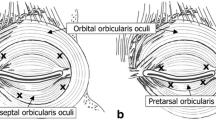Abstract
Benign essential blepharospasm (BEB) and hemifacial spasm are two of the most common movement disorders that affect the face. The etiology of BEB is not known. The most likely etiology of hemifacial spasm is microvascular compression at the facial nerve root exit zone from the brainstem, or less commonly at its entry point into the internal auditory meatus. Botulinum toxin therapy is currently the most common treatment modality for both disorders. Botulinum toxin inhibits the release of acetylcholine at the neuromuscular junction. It should be noted that similar movement disorders can be pharmacologically produced with Levodopa and neuroleptic antipsychotic drugs, both acutely and after long-term therapy.
Access provided by CONRICYT-eBooks. Download chapter PDF
Similar content being viewed by others
Keywords
Indications
-
Patients who display involuntary facial movements that cannot be attributed to a pharmacologic agent, brain lesion, or reflex blepharospasm. Clinical findings in BEB patients may include excessive blinking, photophobia, persistent eye closure secondary to involuntary spasms, and/or contractions of the orbicularis oculi and surrounding muscles. A majority of blepharospasm patients also have involuntary movements of the paranasal muscles, mouth, and jaw. A subset of patients may display forceful contractions of the jaw, tongue, and chin thrusting consistent with oromandibular dystonia. Hemifacial spasm symptoms are characterized by unilateral intermittent clonic or tonic contractions of the muscles of facial expression supplied by the facial nerve. Patients should have been evaluated and deemed appropriate for such surgical intervention. Contraindications to treatment include prior allergic reaction, injection into areas of inflammation, breast feeding, pregnancy category C, diseases of the neuromuscular junction, usage of aminoglycosides , and sensitivity to or concern for human blood products (albumin). Patients should have been educated about the risks and benefits of the procedure, including alternatives.
Essential Steps
-
1.
Per FDA regulations, a copy of the Medication Guide must be provided to the patient for review prior to treatment
-
2.
Administration of topical anesthetic
-
3.
Reconstitute botulinum in vial to desired concentration with unpreserved, sterile saline
-
4.
Mark injection sites with patient in seated, upright position
-
5.
Prep skin with desired antibacterial agent
-
6.
Inject at desired locations at a 45° angle with a 1 cm3 syringe and 30 gauge needle
-
7.
Apply pressure if ecchymosis develops
-
8.
Document units injected per site, type of botulinum injected, lot number of botulinum vial(s) used, and response/reactions to previous treatments
Complications
-
Hemorrhage/hematoma
-
Infection
-
Ecchymosis
-
Asymmetry
-
Ectropion
-
Eyelid ptosis
-
Eyelid retraction
-
Brow ptosis
-
Brow retraction
-
Lagophthalmos
-
Dry eye syndrome
-
Corneal exposure
-
Epiphora
-
Diplopia
-
Lip droop
-
Drooling
-
Swallowing difficulty
-
Difficulty maintaining head position
Template Operative Dictation
Preoperative diagnosis: (1) Benign Essential Blepharospasm (2) Hemifacial Spasm (right/left)
Procedure: Botulinum toxin injections
Postoperative diagnosis: Same
Indication: This ____-year-old (race) (male/female) had developed _____ (list symptoms from above) over the past ____ (months/years) and on clinical evaluation was found to have uncontrolled facial movements consistent with (Benign essential blepharospasm/Hemifacial spasm). A detailed review of risks and benefits of the procedure(s), as well as treatment alternatives, was discussed with the patient. The patient was given the Medication Guide for (type of botulinum used) to review. Following this, the patient elected to undergo the procedure(s) and informed consent was obtained.
Description of the procedure: The patient and operative site(s) were identified and marked with a surgical marking pen with the patient seated upright in the treatment chair. (Topical anesthetic consisting of ___ was applied to the injection areas). The patient’s face was then prepped with (alcohol/betadine/other).
The (type of botulinum) was reconstituted with ____ mL of unpreserved, sterile saline per vial, lot numbers: _____. Using an 18 gauge needle, the botulinum was drawn into a 1 cm3 syringe. A 30 gauge needle was then placed on the syringe for patient injection. Each previously marked site was injected at a 45° angle with the needle positioned (intramuscularly/immediately superior to the muscle). (Pressure was applied to (area) as ecchymosis developed following injection). A total of ___ units of botulinum was injected at the sites as depicted in the diagram . (If unable to produce a diagram due to the limitations of the medical records system, then you will need to list each injection site and the number of units injected at each).
The patient tolerated the procedure well and left the office in stable condition.
Author information
Authors and Affiliations
Corresponding author
Editor information
Editors and Affiliations
Rights and permissions
Copyright information
© 2017 Springer International Publishing Switzerland
About this chapter
Cite this chapter
Czyz, C.N. (2017). Botulinum Toxin Treatment of Benign Essential Blepharospasm (BEB) and Hemifacial Spasm. In: Rosenberg, E., Nattis, A., Nattis, R. (eds) Operative Dictations in Ophthalmology. Springer, Cham. https://doi.org/10.1007/978-3-319-45495-5_128
Download citation
DOI: https://doi.org/10.1007/978-3-319-45495-5_128
Published:
Publisher Name: Springer, Cham
Print ISBN: 978-3-319-45494-8
Online ISBN: 978-3-319-45495-5
eBook Packages: MedicineMedicine (R0)




